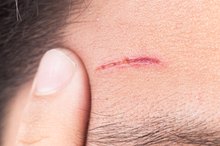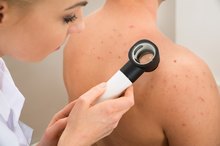Types of Skin Cancer on the Nose
Skin cancer, the most common type of cancer, results from the abnormal and uncontrollable growth of skin cells. Skin cancers can affect many parts of the body, such as the trunk, legs, arms and face and most often affect areas exposed to the sun. The fact that noses protrude from the face makes it more vulnerable to sustaining damage from the sun’s ultraviolet rays. Excessive sun exposure increases the risk of developing one of the types of skin cancer.
Basal Cell Carcinoma
Basal cell carcinoma is the most common type of non-melanoma skin cancer, as well as the most common type of nose cancer 12. It begins in the basal cells. Basal cells reside in the deepest part of the epidermis—the outer layer of skin. Basal cells function to produce more keratinocytes, the main type of cell found in skin.**
A sore or lesion on the nose that fails to heal often indicates the presence of skin cancer. The appearance of the lesion can help determine the type of cancer present. Basal cell carcinoma often produces sores that look pearly white or waxy 1. The white waxy area may look like a scar, making it easy to overlook. Basal cell carcinomas grow slowly and rarely spread to nearby lymph nodes or distant organs. They can, however, cause extensive damage to surrounding tissues. Although easy to treat, basal cell carcinoma causes a high recurrence rate, according to MayoClinic.com 13.
- Basal cell carcinoma is the most common type of non-melanoma skin cancer, as well as the most common type of nose cancer 1.
- Basal cells function to produce more keratinocytes, the main type of cell found in skin.
Squamous Cell Carcinoma
Ear Signs of Skin Cancer
Learn More
Squamous cell carcinoma, also classified as a non-melanoma cancer, is the second most common type of cancer that can affect the nose, and begins in the flat cells located in the outermost layer of epidermis known as the stratus corneum 2. These flat cells, known as squamous cells, form the final layer of living cells in the epidermis. Squamous cell carcinoma accounts for approximately 20 percent of the nearly 1 million cases of skin cancer diagnosed each year, as reported in 2010 by the American Academy of Dermatology 2.**
Squamous cell carcinoma produces a red patch on the skin, often appearing scaly or crusted. A red nodule that feels firm to the touch may also indicate squamous cell carcinoma. Squamous cell carcinoma is more aggressive than basal cell carcinoma if left untreated, and can spread to nearly lymph nodes or metastasize to other organs 12.**
- Squamous cell carcinoma, also classified as a non-melanoma cancer, is the second most common type of cancer that can affect the nose, and begins in the flat cells located in the outermost layer of epidermis known as the stratus corneum 2.
- Squamous cell carcinoma produces a red patch on the skin, often appearing scaly or crusted.
Melanoma
Skin contains two main types of cells: the keratinocytes that produce the protein keratin, and melanocytes that produce the pigment called melanin. Melanoma cancers begin in the melanocytes. Benign tumors of the melanocytes, known as moles, often make it difficult to detect the presence of melanoma cancer.
Because melanomas begin in the melanocytes, these cancers usually produce skin lesions that look brown or black, but may also cause a lesion with no color. Melanomas can develop anywhere on the body, but most often develop in areas that have had exposure to the sun including the nose and the rest of the face. If left untreated, melanomas can spread to the lymph nodes and other organs in the body. Although much less common than the other types of skin cancer, melanoma causes the most skin cancer deaths, as reported by the American Cancer Society.
- Skin contains two main types of cells: the keratinocytes that produce the protein keratin, and melanocytes that produce the pigment called melanin.
- Because melanomas begin in the melanocytes, these cancers usually produce skin lesions that look brown or black, but may also cause a lesion with no color.
Related Articles
References
Writer Bio
Stephanie Chandler is a freelance writer whose master's degree in biomedical science and over 15 years experience in the scientific and pharmaceutical professions provide her with the knowledge to contribute to health topics. Chandler has been writing for corporations and small businesses since 1991. In addition to writing scientific papers and procedures, her articles are published on Overstock.com and other websites.









